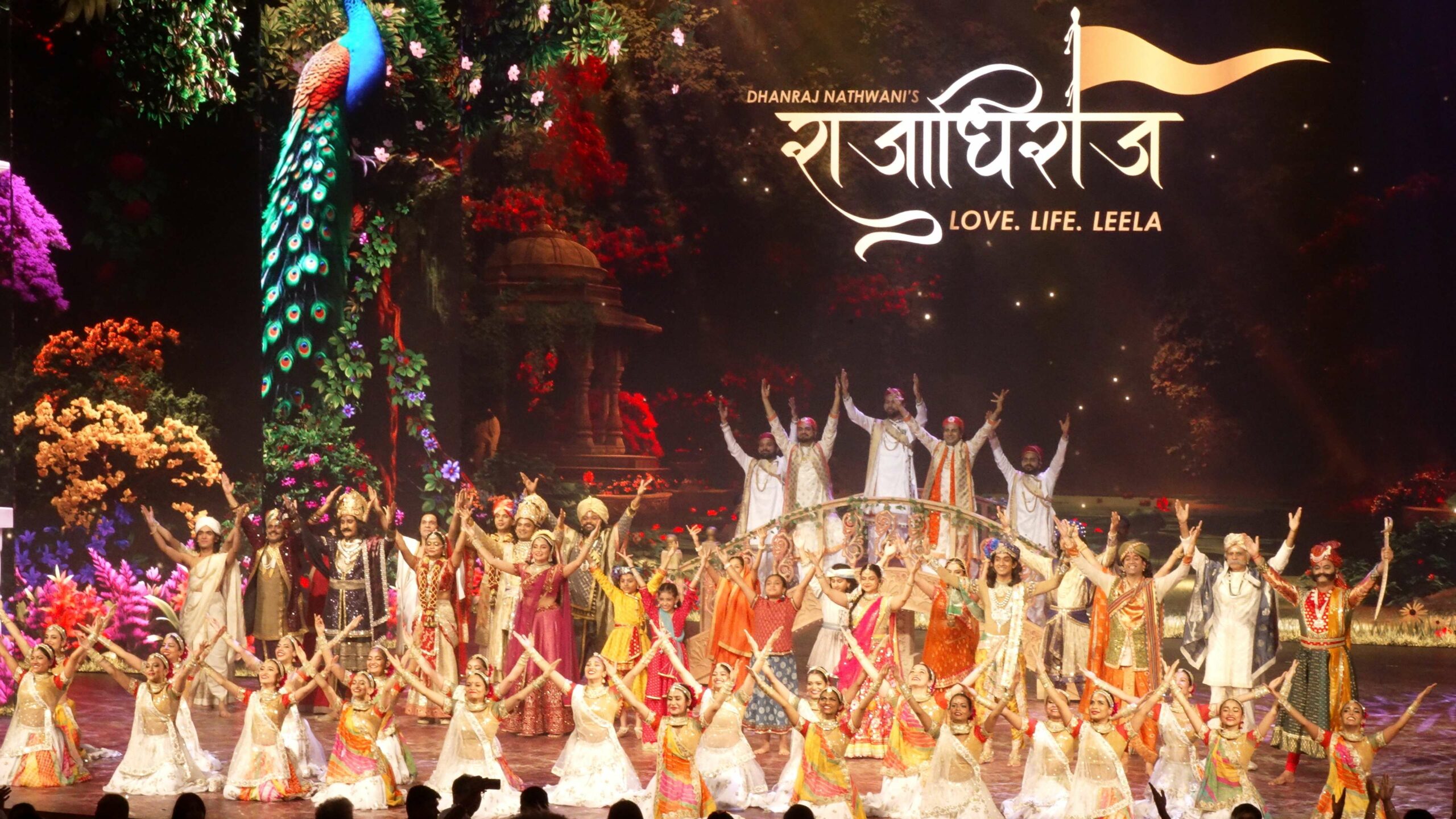
Rajadhiraaj: The Theatrical Marvel That Brings Shri Krishna’s Life to the Stage
The timeless story of Shri Krishna comes alive, resonating deeply with people across all age groups. In the vibrant world of Indian theatre, Rajadhiraaj: Love, Life, Leela emerges as a tribute to the divine, offering audiences a unique and immersive experience that celebrates the life and legacy of one of India’s most revered deities.
The moment audiences’ step into the Grand Theatre at NMACC, they are transported into a world of divine splendour. Here, the life and teachings of Shri Krishna are brought to life in a way that transcends mere theatricality.
This ambitious musical is the brainchild of Dhanraj Nathwani, whose deep devotion to Krishna inspired him to create a production that blends tradition with innovation. Nathwani’s vision is meticulously realized by Executive Producer Bhoomi Nathwani, whose attention to detail ensures that every aspect of the production is executed with passion and precision. Together, they have shaped a theatrical experience that honours Krishna’s story while resonating with contemporary audiences.
Leading this ambitious production is Director, Shruti Sharma. With a background in directing large-scale musicals such as Disney’s Aladdin, Sharma infuses Rajadhiraaj with a unique blend of youthful dynamism and artistic sensitivity. “When we set out, our goal was to evoke a deep sense of nostalgia, to make everyone feel as though the stories of Krishna they grew up with had come alive,” Sharma shares. Her vision was to recreate the enchanting world of Krishna’s Vrindavan on stage, allowing the audience to step into a living, breathing myth. Sharma’s fresh perspective breathes new life into the narrative, ensuring Rajadhiraaj resonates with viewers, bridging tradition and modernity. Her direction is driven by a respect for Krishna’s story and a dedication to making his world accessible to a diverse audience. The challenge of capturing the diverse facets of Krishna’s life—from the playful Shrinathji to the majestic Dwarkadheesh—was one Sharma embraced with enthusiasm.
At the heart of Rajadhiraaj is its narrative, penned by the renowned lyricist and screenwriter Prasoon Joshi. Joshi, who has breathed life into many iconic stories through his words, approached this project with reverence and a deep sense of responsibility. “Writing for Lord Krishna, who is beyond human comprehension, was the biggest challenge,” Joshi reflects. He describes the process as a “spiritual journey,” one that required a delicate balance between artistic creativity and cultural authenticity. The musical delves into lesser-known aspects of Krishna’s life, offering fresh perspectives while staying true to the timeless tales cherished across generations.
The production weaves together storytelling, music, and visual spectacle to captivate audiences. Joshi’s powerful script is brought to life through 20 original songs composed by Sachin-Jigar, blending Western symphonic elements with Indian classical music. These songs deepen the audience’s connection to Krishna’s tale, making it a perfect tribute to his legacy. Talking about the process, they said, “Our goal was to create a grand musical experience that blends the spiritual essence of Krishna’s story with the dramatic impact of a Western symphony orchestra. We were deeply inspired by legends like A.R. Rahman and Ajay-Atul, and we felt a responsibility to bring this kind of musical grandeur to the theatre for the first time, especially for a story as profound as Krishna Leela.” They added, “Creating music for Rajadhiraaj was a unique challenge because it had to resonate with every audience, young and old alike. We carefully crafted each piece to not only reflect the diverse phases of Krishna’s life but also to ensure that the overall experience stays with the audience long after they leave the theatre.”
The visual grandeur of Rajadhiraaj is the handiwork of acclaimed production designer Omung Kumar, known for his work on blockbuster films like Mary Kom and Sarbjit. Kumar revealed the meticulous process behind creating the awe-inspiring sets that transport the audience to ancient India. “The challenge was to condense the grandeur of places like Dwarka and Mathura onto a single stage. We wanted each scene to be instantly recognizable, whether it’s the white and gold tones of Dwarka or the sandstone hues of Mathura,” he explains. Kumar’s attention to detail is evident in every aspect of the production, from the majestic sets that seamlessly transition between scenes to the symbolic elements that convey deeper meanings. One particularly striking moment is the depiction of Krishna lifting Govardhan Parvat, a feat that has left audiences in awe. “Seeing Krishna ‘raise’ the mountain with one finger and witnessing the audience’s reaction was incredible,” Kumar shares with a sense of pride.
Complementing Omung’s set design is the exquisite costume design by Neeta Lulla, who has meticulously created over 1800 costumes for the show. Her designs blend authenticity with creativity, paying homage to traditional depictions of Krishna while also infusing them with a modern, larger-than-life aesthetic. Neeta reflects on her process, saying, “To create a Krishna that would look larger than life on the scale of the show was the story itself. The inspiration was a play of fabrics, textures, and pure hand-woven materials, creating an ethereal look that transcends the ordinary.” Lulla’s commitment to both authenticity and innovation is evident in every thread and fabric. Each costume reflects the specific cultural and historical context of Krishna’s life, from the pastoral simplicity of Gokul to the regal splendor of Dwarka. “The entire storytelling was based on villages and areas from where Krishna hailed. Krishna’s story is rich with symbolism, and I wanted the costumes to reflect that—whether it’s the colors used, the motifs, or the fabrics,” she notes. This attention to detail ensures that the production not only honors the traditional tales of Krishna but also brings a fresh perspective that resonates with contemporary audiences.
One of the most remarkable aspects of the musical is its choreography, which features a fusion of classical, contemporary, and folk-dance forms. Choreographers Shampa and Bertwin D’souza, who have crafted the dance sequences, approached the task with deep reverence and creativity. Bertwin explains, “For us, choreography is not just about putting dance steps together, but crafting meaningful movements that paint a picture and evoke an emotion. The beautiful story of Shree Krishna transports us back in time so we didn’t really think about mixing traditional with modern, but rather just trusted our experience and artistic instincts, letting the divine power guide us in telling the story in a way that would resonate with all kinds of audiences. Working with over 180 artists is definitely a tall order. We could not create our choreographic pieces without being aware of the capabilities of each of our artists. Intense movement workshops allowed us to assess them and design the acts, keeping their characters in mind as well as their abilities.”
With every seat sold out across shows, this production stands out as an unmissable event, not just for its religious significance but also for its artistic mastery. The musical’s unique combination of storytelling, design, and performance makes it a groundbreaking experience in Indian theatre. In the words of Prasoon Joshi, “The play will resonate differently with each person.” And indeed, as the final curtain falls and the audience is left in a state of awe, Rajadhiraaj leaves a lasting impression—a reminder of the divine essence of love, life, and leela that Krishna embodies.
